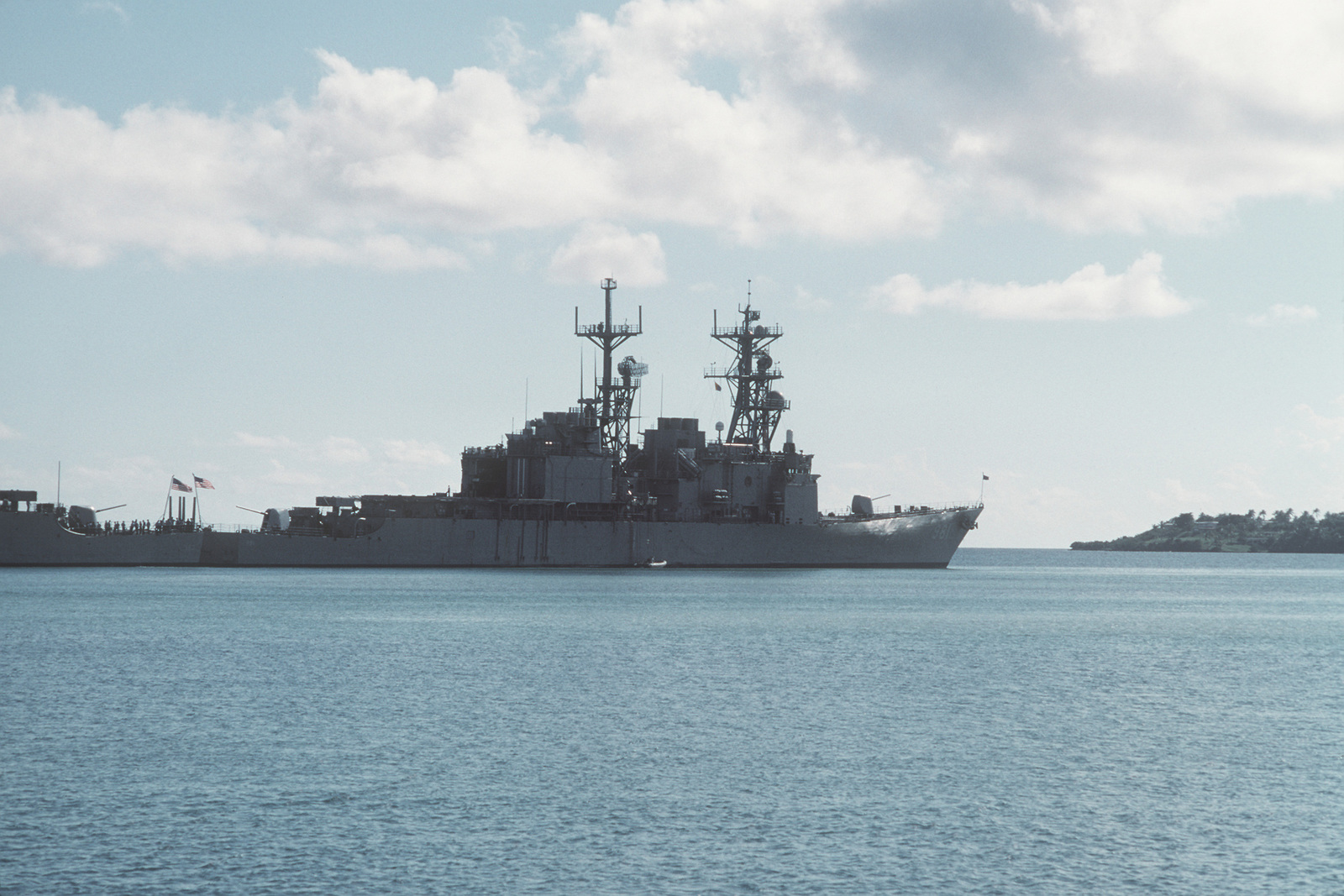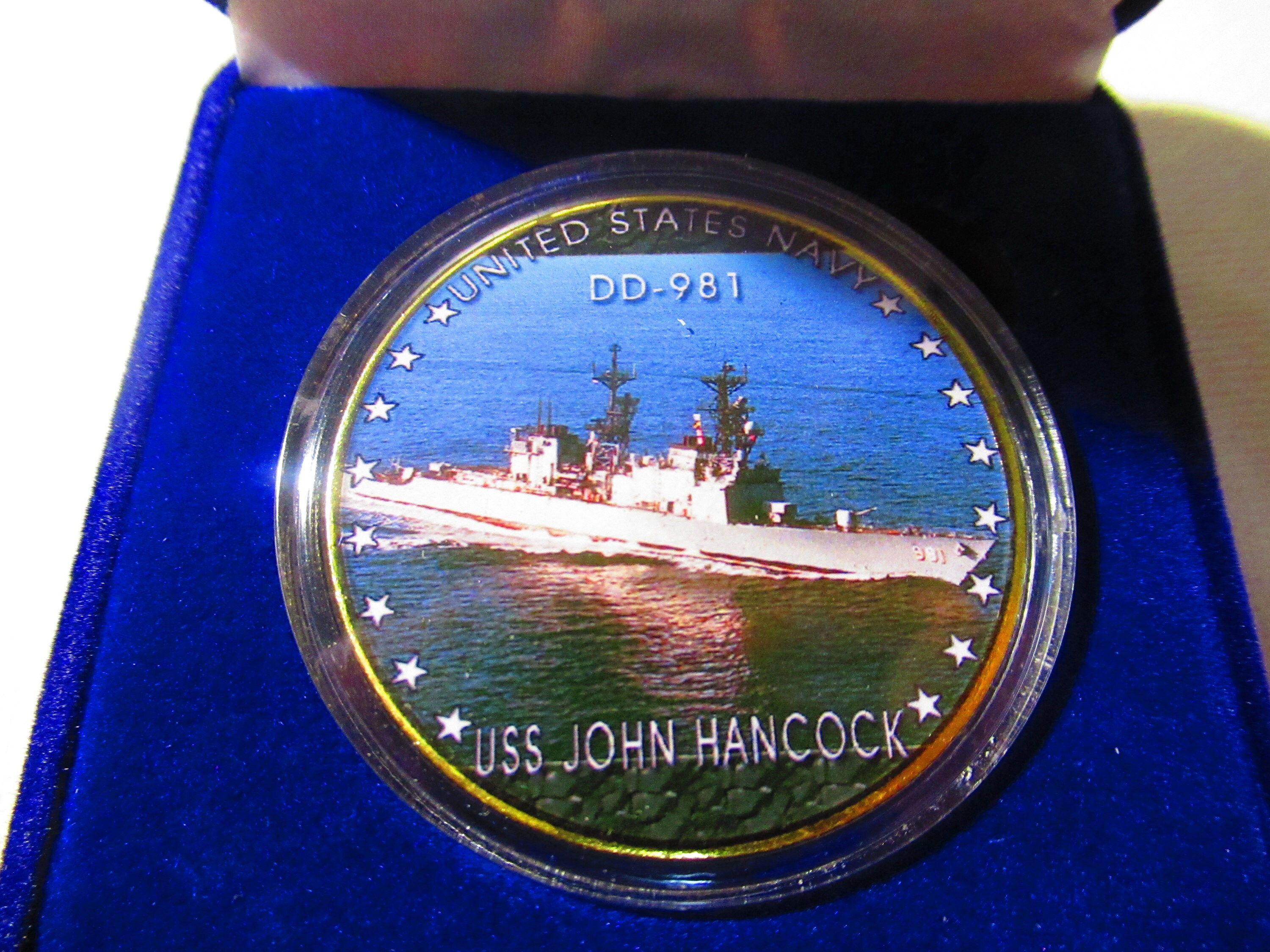Uss John Hancock - Size of this foreground: 800 × 532 pixels. Other resolutions: 320 × 213 pixels | 640 × 426 pixels | 1, 024 × 681 pixels | 1, 280 × 852 pixels 2,840 × 1,890 pixels.
A stark scene of the USS John Hancock (DD-981) unique name display commemorating the signing of the Declaration of Independence by John Hancock.
Uss John Hancock

This file is the work of a sailor or employee of the United States Navy and is work obtained or created in the course of that person's duties. As a US federal government job, it is in the public domain in the United States.
Uss John L Hall Ffg 32 Box Framed Canvas Art
This file is designated as such without known restrictions under copyright law, including all related and neighboring rights.
A stark scene of the USS John Hancock (DD-981) unique name display commemorating the signing of the Declaration of Independence by John Hancock. {{info|source=[http://www.dodmedia.osd.mil/Assets/Still/1982/Na
This file contains additional information such as Exif metadata added by a digital camera, scanner, or software application. If the file has been modified from its original state, some information such as timestamps may not fully reflect the original file. Timestamps are only as accurate as the camera clock, which can be completely wrong. This article requires additional citations for verification. Please help improve this article by adding references from reliable sources. Unsourced content may be challenged or removed. Find Source: "USS John Hancock" DD-981 – News · Newspapers · Books · Scholars · JSTOR (July 2019) (Learn how and from whom to remove this style of message)
USS John Hancock (DD-981) was a Supervans-class destroyer, the sixth ship in the United States Navy, and named after Founding Father John Hancock (1737–1793). President. Continental Congress, first signer of the Declaration of Independence.
Uss John Hancock Dd 981 Framed Navy Ship Photo Burgundy
John Hancock was buried on 16 Jan 1976 at the English Shipyard in Pascagoule, Miss. Commissioned on October 29, 1977 and commissioned on March 10, 1979. John Hancock was assigned to the Atlantic Fleet and homeported in Charleston, South Carolina from 1979 to 1987. Since 1987, John Hancock has been home at Naval Station Mayport, Florida.
After commissioning, the John Hancock departed Guantanamo Bay, Cuba for a "scrubbing" tour and began regular operations.
In March 1983, John Hancock reported on a six-month overhaul at the Ingalls Shipyard in Pascagoule, Mississippi. After the overhaul, John Hancock spent three months in Cuba, where the crew successfully revalidated GITMO at Guantanamo Bay Naval Station, Cuba, before deploying in support in the Persian Gulf from October 1984 to April 1985. What did you do? John Hancock and several other ships in September 1984 in Charleston, South Carolina to get out of the path of a hurricane. John Hancock was shot during a "flag guard" patrol in the Persian Gulf during the tank war between Iraq and Iran. An Iraqi Mirage fighter jet fired an Exocet missile, causing a disaster. The missile heavily damaged a salvage tug in the direct line of fire.

In April 1988, John Hancock assisted in a six-month deployment to the Persian Gulf during Operation Ernst Will, near the site of the 1987 Iraqi Air Force aircraft shooting down the USS Stark with two Exocet missiles.
Dd 981 Uss John Hancock Patch
In 1991, John Hancock deployed to the North Atlantic for two months with the US Carrier Battle Group in support of Operation North Star 91.
In March 1994, John Hancock assisted an injured Filipino sailor on board a merchant ship while on duty in the Red Sea. Shortly thereafter, John Hancock achieved significant success by launching the Multinational Naval Sanctions Operation (MIO) to enforce UN sanctions against Iraq. On April 1, 1994, the USS John Hancock, Carr, Underwood, and Taylor, along with a US Coast Guard team, intercepted the 20,000th vessel since sanctions were imposed in August 1990. .
John Hancock was redesignated Destroyer Squadron 24 (DESRON 24) as part of the July 1995 reorganization of the US Atlantic Fleet's surface combatants into six main battle groups, nine destroyer squadrons, and a new Western Hemisphere group. The restructuring was to be phased in over the summer, to take effect on August 31, 1995, and to be carried over to the home until 1998.
The John Hancock was one of 13 Navy ships in September 1996 to prevent a hurricane in France. The hurricane currently has sustained winds of 120 mph toward the southeast coast of Florida.
Uss John F. Kennedy (cv 67) Mediterranean Cruise Book 1999 2000
In 1996, the USS John Hancock, USS Wasp, USS Carl Vinson, USS Anchorage, and USS George Washington were selected to serve as the P2's test platform after a Navy installation study. The amount of toxic and hazardous waste at the naval base was collected from floating materials on ships and stored during disposal. The P2 Afloat program aims to reduce the cost of purchasing hazardous materials for ships, improve the safety and health of ships, improve quality of life, and reduce operating and support costs.
On April 29, 1997, John Hancock departed for a six-month overseas assignment as part of the USS John F. Kennedy Carrier Battle Group (CVBG). The USS Kearsarge Amphibious Ready Group (ARG) was also underway. The CVBG was to replace the USS Theodore Roosevelt CVBG, which had been operating in the Mediterranean, Adriatic Sea, Red Sea and Persian Gulf since last November. John F. Kennedy's CVBG and Kearsarge ARG completed a joint task force exercise (JTFEX) a month ago, completing nearly six months of pre-deployment training and practice. Joint military exercises included surveillance, rescue, humanitarian assistance, maritime interdiction, embassy support, and non-combatant evacuation, all performed by Navy and US Marine Corps units deployed overseas.
In August 1997, John Hancock went to participate in exercise NADOR 97-3 off the coast of Tunisia. John Hancock was also there at NADOR 97-2 in March. For NADOR 97-3, John Hancock's crew worked with two Tunisian combat patrol boats to increase the level of difficulty. They conducted aerial and high-speed surface gunnery exercises, aerial observation, gauge simulation, and free game "counter" exercises. John Hancock also interdicted the sea by boarding two patrol boats. Patrol boats, simulating merchant ships, were interrogated by radio from bridge to bridge. After checking the responses of the suspected traders, John Hancock's crew escorted each vessel using a rigid inflatable boat (RHIB). The flight crew inspected each merchant's manifest and cargo and instructed the suspect vessel to continue its voyage or proceed to the nearest port for a full cargo inspection.

John Hancock participated in the 12-nation US 6th Fleet Invitex exercise with the John F. Kennedy CVBG in July. During Invitex, coalition forces, including 13,000 U.S. Sailors and Marines, were challenged to manage how to effectively communicate and process operational information as it is processed and shared with coalition decision makers. It also participated in NATO's Dynamic Mixed Exercise, which took place from September 23 to October 7, and deployed units from the John F. Kennedy Battle Group on opposite sides. The exercise aims to improve the readiness of task forces and units while implementing NATO strategy and doctrine.
Uss Hancock Cv 19 Decal
John Hancock returned home Oct. 28 after spending six months in the Mediterranean and Adriatic Sea supporting Operation Mission Sentinel and Operation Southern Sentinel in the Persian Gulf.
John Hancock attended the 6th International Naval Review (INR) in New York City, July 3-9, 2000.
On 16 October 2000, John Hancock was decommissioned and towed to Philadelphia, Pennsylvania, where she was placed in reserve at the Naval Intermediate Ship Maintenance Facility in Philadelphia. It was sold in 2006 to International Shipbreaking Ltd. of Brownsville, Texas. She was towed to Brownsville Harbor on April 29, 2007 and abandoned.
The official coat of arms of John Hancock symbolizes John Hancock's service to his country as president of the Continental Congress and chairman of the Navy Committee. The dominant colors of the coat of arms are the blue and gold traditionally used by the United States Navy.
The Abandoned Destroyer Class
The shield represents the Navy Committee of which John Hancock was the first chairman. This committee was responsible for naval affairs, now assigned to the United States Department of the Navy. As chairman, John Hancock oversaw the construction and assembly of thirty frigates in the original shipbuilding program. At this time, a second ship, the John Hancock, was built and commissioned in the Navy.
The white and blue wavy bars on the shield are emblematic of water, and the anchor is a symbol of maritime communication. The sun, symbolizing birth, has thirty rays with thirty stars representing thirty frigates.
John Hancock, the original signer of the Declaration of Independence, also presided over the Massachusetts Convention that ratified the Constitution of the Union. This
Uss hancock association, uss lewis hancock, uss john hancock dd 981, uss hancock cv 19, uss hancock, uss hancock cva 19, uss hancock model, uss hancock crew list, uss john hancock aircraft carrier, uss hancock deployments, uss hancock cva 19 crew list, uss hancock cruise book
0 Comments